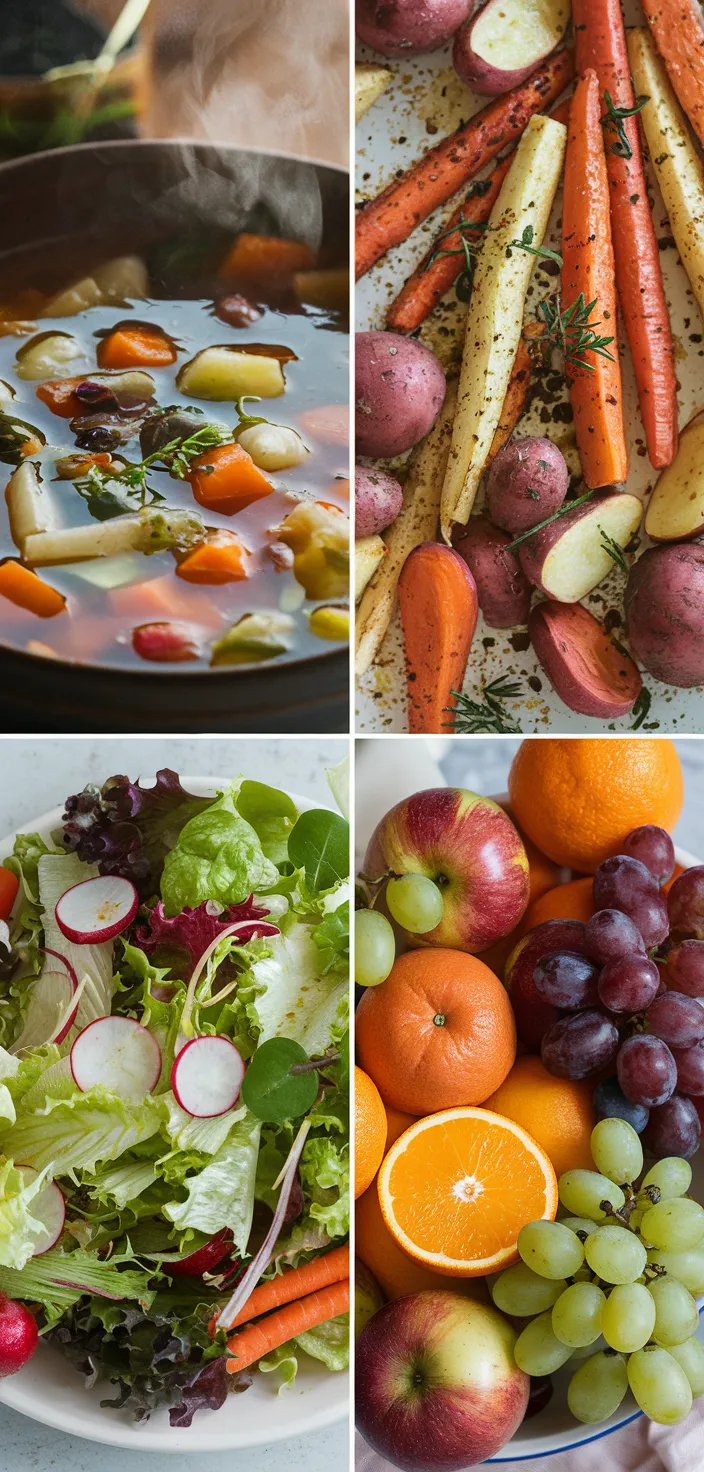As the chill of winter settles in each January, I find myself irresistibly drawn to the warm and easy recipes that fill the belly and warm the heart. The kitchen in my small apartment may be space-constrained, but it is alive with the earthy, comforting smells of roasted parsnips and, even more deliciously, the enticing aromas of the stews that fill my cast iron and Dutch ovens to the brim with all kinds of hardy root vegetables and nutrient-rich winter foods.
They’ve become my go-to, and I think the bright notes of winter citrus bring just the right contrast to the richness of the rich, savory dishes that I like to prepare at this time of year.
The 19 Best January recipes
1. January Lentil Soup
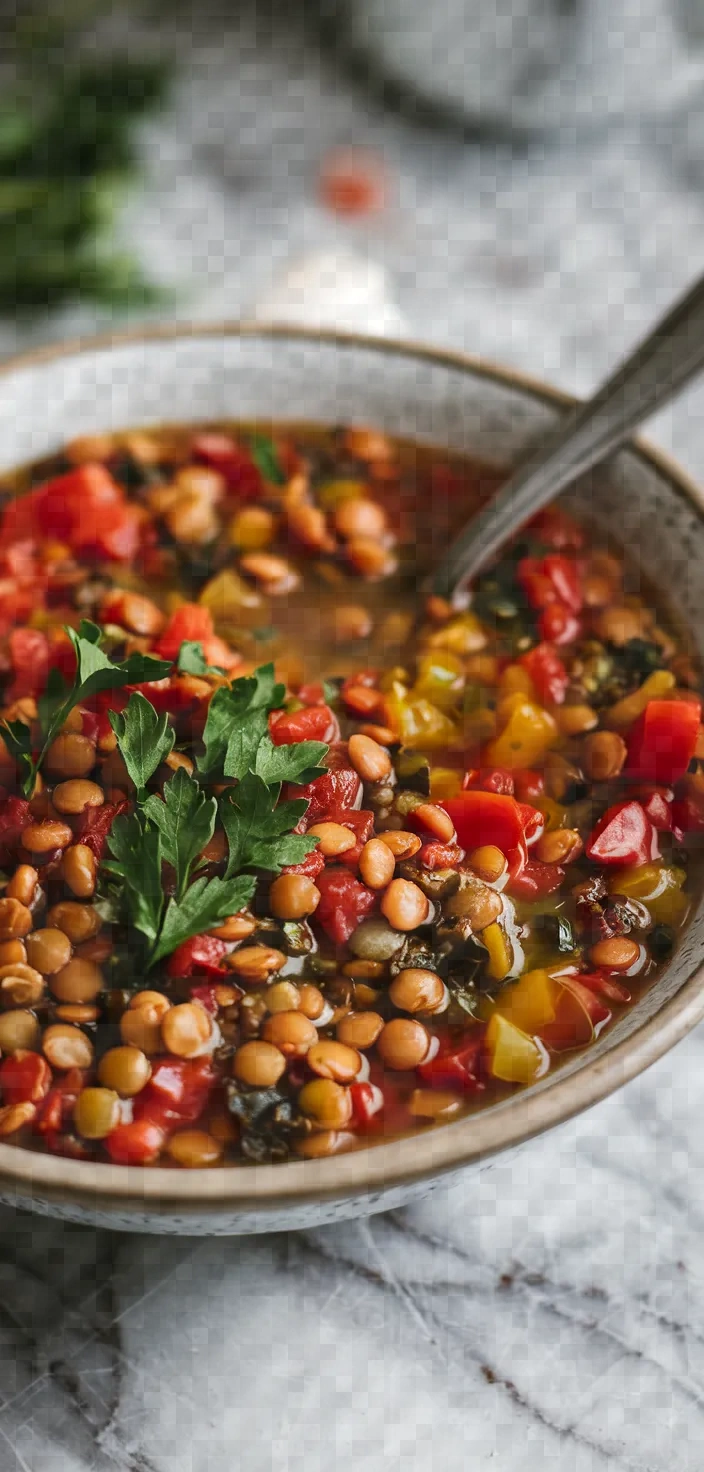
A comforting combination that is perfect for cold-weather days, January Lentil Soup is a blend of warm lentils, diced tomatoes, and a variety of delicious spices. It’s the kind of meal that you can’t help but feel good about, not just because it is so tasty (and so easy to make), but also because it’s darn healthy.
Full of good-for-you ingredients like lentils, tomatoes, and spices that have all kinds of health benefits, this soup qualifies as super nutrition.

Ingredients
2 tablespoons olive oil
1 onion, chopped
2 carrots, diced
2 celery stalks, diced
3 cloves garlic, minced
1 teaspoon ground cumin
1 teaspoon smoked paprika
1/4 teaspoon cayenne pepper (optional)
1 (14-ounce) can diced tomatoes
2 cups dried lentils, rinsed and drained
6 cups vegetable broth
2 bay leaves
Salt and pepper, to taste
1 tablespoon red wine vinegar
1/4 cup chopped fresh parsley
Instructions
1. In a sizable pot, pour in the olive oil and bring it to a medium warmth. Introduce the diced onion, carrot, and celery to the pot. Sauté these aromatic ingredients until they become tender and fragrant, which should take about 5-7 minutes.
2. Add the garlic, cumin, smoked paprika, and cayenne pepper, then cook for an additional 1-2 minutes, or until aromatic.
3. Incorporate the canned diced tomatoes with their juice, lentils, vegetable broth, and bay leaves. Bring everything to a boil.
4. Lower the heat and let it slow down to a simmer. Cover the pot and let it cook for 25-30 minutes. This will allow the lentils to absorb the water and also to become tender but not mushy.
5. Take out the bay leaves, add the red wine vinegar, and taste the soup. Does it need more salt and pepper? Then serve.
6. Present the dish piping hot, with an adornment of fresh parsley. Relish in the delightfully healthy and warming nature of the January offering that is lentil soup!
2. Winter Citrus Salad

In the chill of winter, I find that a lively citrus salad really hits the spot. The one I make most frequently stars not only the usual suspects—sweet oranges and tart grapefruit—but also adds thinly sliced fennel for a refreshing crunch.
Fennel tastes like licorice, and its mild anise flavor pairs beautifully with the pomegranate seeds and toasted almonds, which provide pops of sweetness and crunch, respectively.

Ingredients
2 large oranges (such as navel or blood oranges)
1 grapefruit
1 fennel bulb, thinly sliced
1/4 cup pomegranate seeds
1/4 cup sliced almonds, toasted
2 tablespoons olive oil
1 tablespoon lemon juice
Salt and freshly ground black pepper to taste
A handful of fresh mint leaves, torn into pieces
Instructions
1. Remove the peel and slice the oranges and grapefruit into rounds or segments, taking out any seeds and their pith.
2. On a serving plate, arrange the fennel and citrus slices.
3. Sow the pomegranate seeds and toasted almonds on top.
4. Season with salt and pepper to taste, then drizzle with olive oil and lemon juice.
5. Before serving, add fresh mint leaves as a garnish.
3. January Hearty Beef Stew
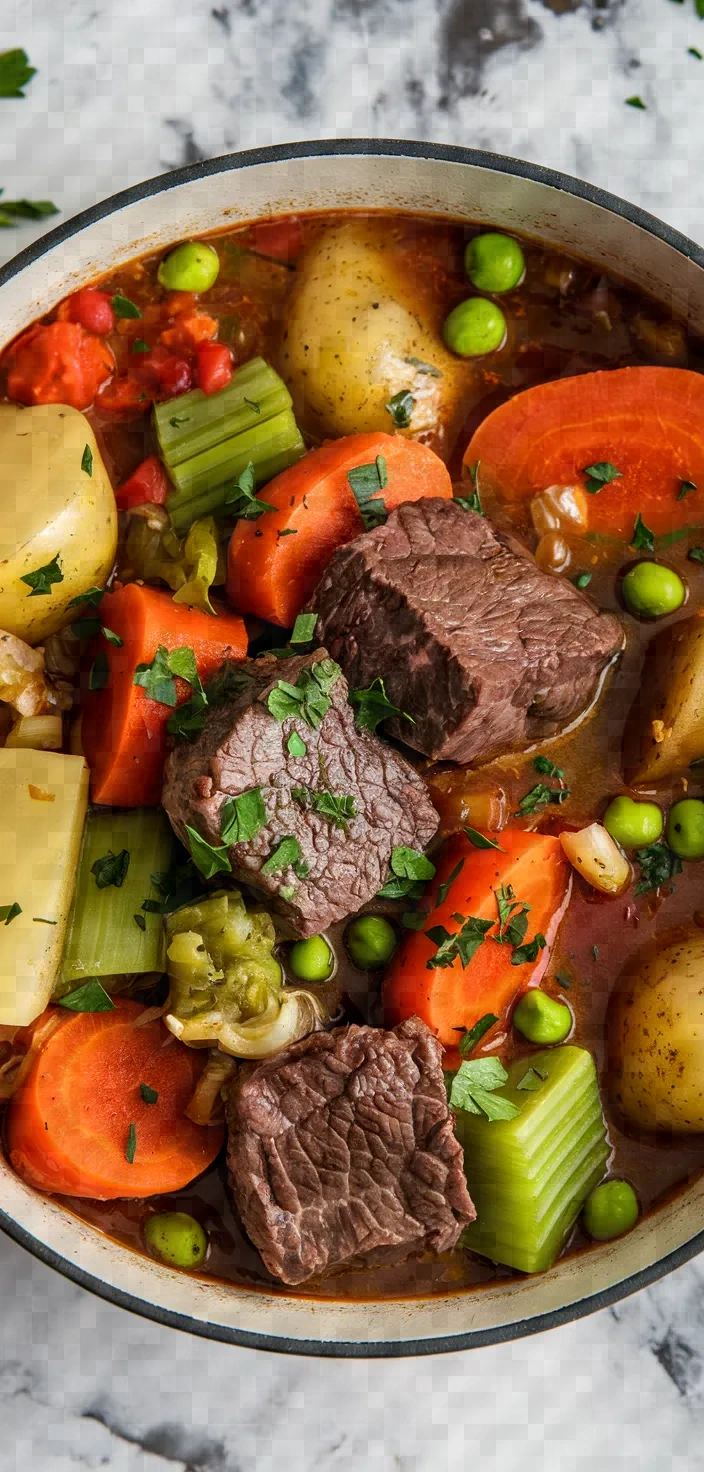
I hold dear the warm and comforting nature of a full-bodied beef stew. I use tender beef chuck, earthy carrots, and a strong beef broth.
The broth includes potatoes (not traditional), a hint of Worcestershire sauce, and beef bones that have simmered in a “slow death” for a full 24 hours. Use fresh parsley and thyme for depth; these are the only herbs I allow in this dish.
The Worcestershire sauce gives it a little kick, while the parsley and thyme make it smell great. Your kitchen will smell incredible.

Ingredients
- 2 pounds beef chuck, cut into 1-inch cubes
- 3 tablespoons all-purpose flour
- Salt and freshly ground black pepper
- 2 tablespoons olive oil
- 1 onion, chopped
- 3 cloves garlic, minced
- 4 cups beef broth
- 2 tablespoons tomato paste
- 1 tablespoon Worcestershire sauce
- 1 teaspoon dried thyme
- 4 carrots, cut into 1-inch pieces
- 3 potatoes, peeled and cut into 1-inch cubes
- 2 stalks celery, sliced
- 1 bay leaf
- 1 cup frozen peas
- 2 tablespoons chopped fresh parsley
Instructions
1. In a big bowl, add the beef cubes and dust them with flour, salt, and pepper until they’ve been evenly coated.
2. In a big pot or Dutch oven, pour olive oil and heat it over medium-high. If you didn’t get two pounds of beef already cut into cubes, do so first. Then, brown those in batches, removing each one when it’s adequately brown, and setting it aside.
3. In a single pot, combine the onion and garlic, and sauté until they are softened. Then pour in the beef broth and add the tomato paste, Worcestershire sauce, thyme, and bay leaf. Stir to mix well, and bring to a boil.
4. Put the beef back into the pot and lower the heat to a simmer. Cover the pot and cook for 1.5 to 2 hours until the beef is tender.
5. Put the carrots, potatoes, and celery in the pot, and keep simmering for 30 more minutes, until the veggies are tender.
6. Add the peas and parsley; take out the bay leaf; and check the salt and pepper. Then heat and serve.
4. Root Vegetable Mashed Potatoes
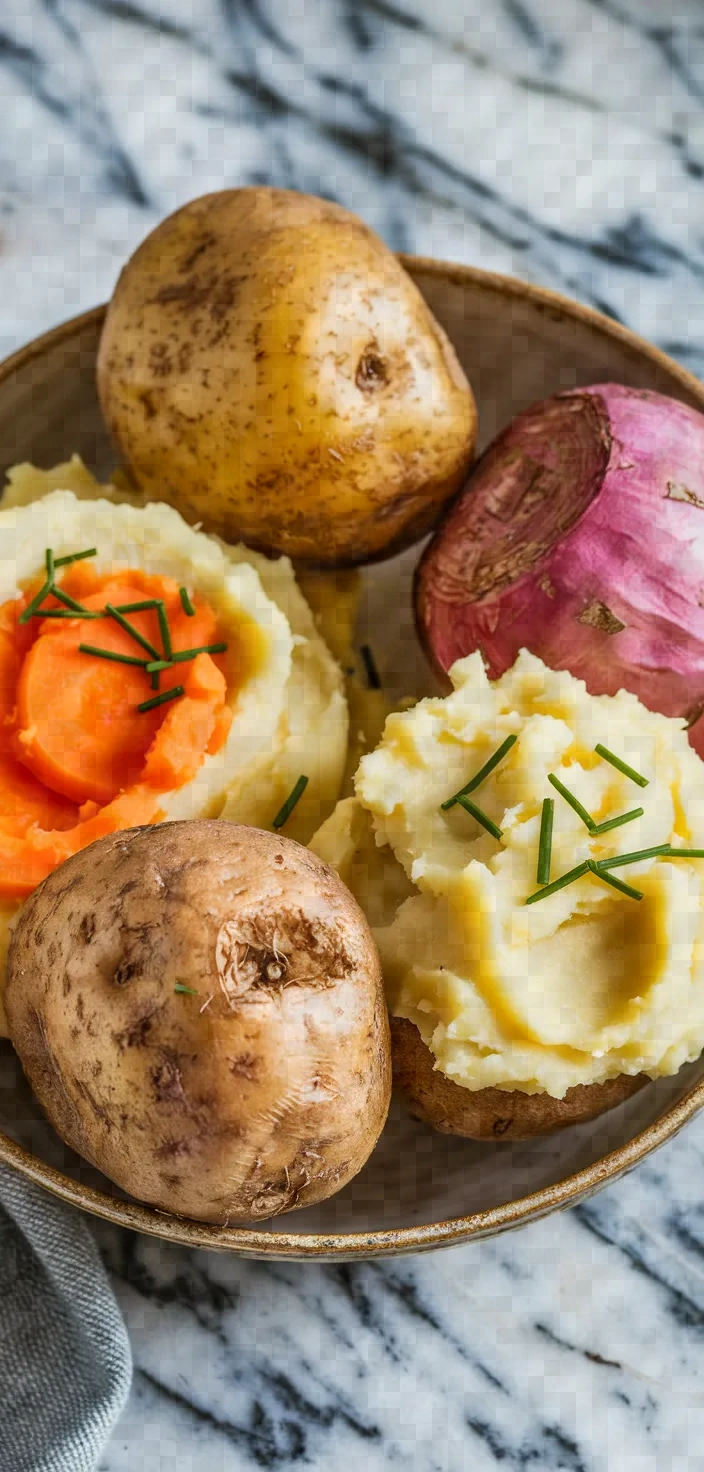
Mashing russet potatoes with parsnips, turnips, and carrots elevates this dish to something much more flavorful and interesting. The beautiful blend of root vegetables puréed with rich butter and heavy cream renders a smooth, rustic dish that’s seasonally perfect.
I only add salt and pepper, and I never fail to garnish with fresh chives, which, for me, are the sine qua non of mashed anything.

Ingredients
2 large russet potatoes, peeled and chopped
1 large parsnip, peeled and chopped
1 medium turnip, peeled and chopped
2 medium carrots, peeled and chopped
4 tablespoons unsalted butter
1/2 cup heavy cream
Salt and pepper to taste
1 tablespoon fresh chives, chopped (optional, for garnish)
Instructions
1. Prepare the Vegetables: The russet potatoes, parsnip, turnip, and carrots should be peeled and chopped into pieces of similar size for even cooking.
2. Cook the Vegetables: Put the vegetables that you have cut up into a big pot and cover them with cold water. Add a little salt and start heating the pot on the stove until the water boils. Once it reaches a rolling boil, reduce the heat and let the pot simmer for about 15-20 minutes until everything in it has become tender.
3. Drain and Mash: Well drain the vegetables, and place them in the pot. Using a potato masher or ricer, mash the vegetables in the pot. Continue until the mixture is smooth and without lumps.
4. Add Butter and Cream: In a tiny saucepan, heat the butter and cream until the butter melts and the mixture warms up. Then, slowly add the cream and butter to the blended vegetables, stirring as you go to ensure everything is well mixed and completely smooth.
5. Season and Serve: Add salt and pepper to the mashed potatoes to your liking. If you want to, you can garnish with dried chives. Otherwise, just serve the mashed potatoes hot.
5. January White Bean Chili
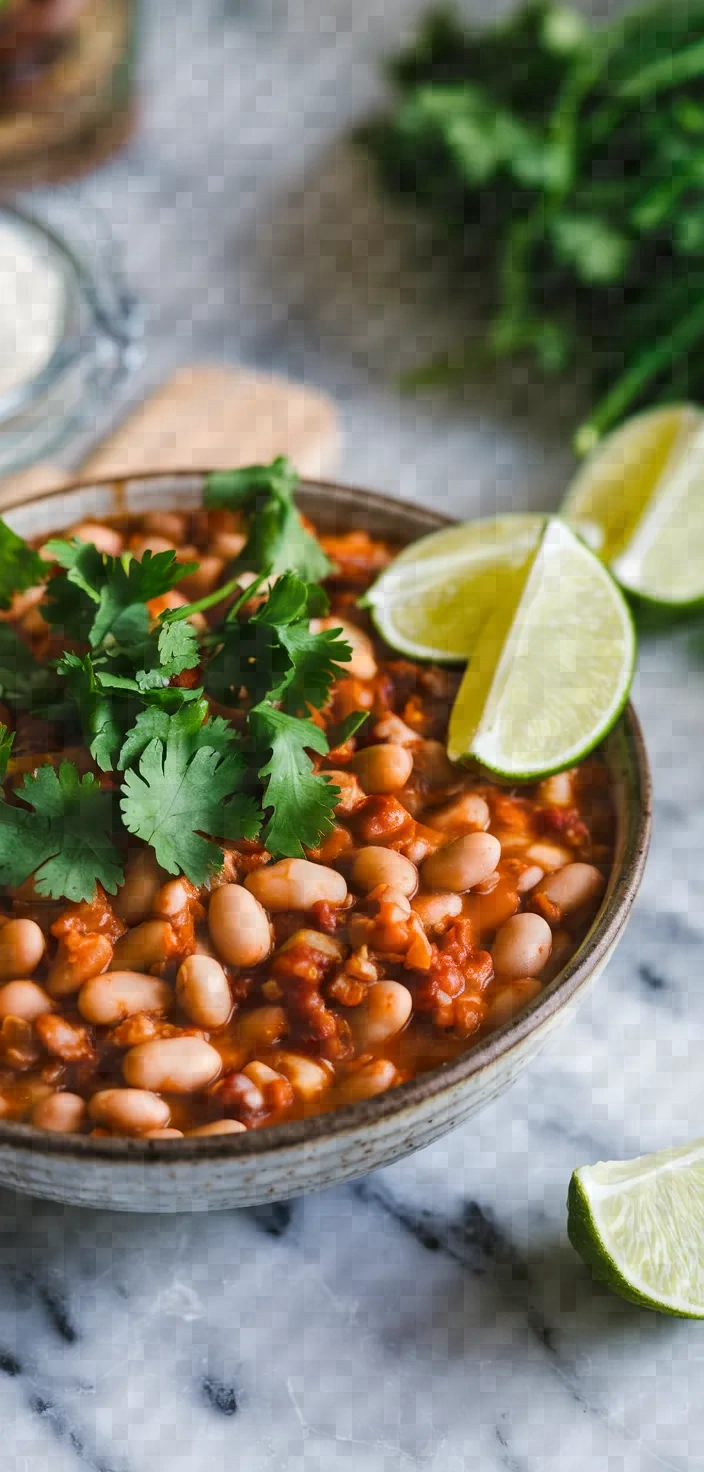
Personally, on a bitterly cold January day, I can’t think of anything better than a warm, comforting bowl of white bean chili. Certainly, its base of white beans, bound together with diced green chiles, makes for a wonderful and hearty chili.
But for me, the true magic happens when you add a combination of spices that would make even the most dedicated of chili purists raise an eyebrow. Yes, there’s cumin, and yes, there’s oregano.
But whether or not you choose to add the optional shredded chicken, this isn’t a chili that’s short on true deliciousness or one that’s fatigued from hanging around in the pot for too long.

Ingredients
2 tablespoons olive oil
1 medium onion, diced
3 cloves garlic, minced
1 tablespoon ground cumin
1 teaspoon dried oregano
1/2 teaspoon chili powder
1/2 teaspoon cayenne pepper (optional)
2 cans (15 ounces each) white beans, drained and rinsed
1 can (4 ounces) diced green chilies
4 cups chicken or vegetable broth
2 cups cooked shredded chicken (optional)
Salt and pepper to taste
1/4 cup fresh cilantro, chopped (for garnish)
Lime wedges (for serving)
Instructions
1. In a spacious pot, warm the olive oil on a medium flame. Toss in the onion, now diced, and cook it until it’s softened and nearly transparent, which should take about 5 minutes.
2. In the pot, combine minced garlic, cumin, oregano, chili powder, and cayenne pepper. Sauté the mixture for one more minute—until the spices become aromatic—to release their flavor.
3. Incorporate the white beans, chopped green chiles, and broth of your choosing into the mixture. Increase the heat and stir until the contents are a uniform blend. Once that is achieved, bring the broth and the rest of the mixture up to a simmer.
4. Incorporate the shredded chicken into the chili. Cook together for about 20 minutes, stirring it now and then to keep the chili from settling. This will give the two dishes a chance to meld.
5. Add salt and pepper to the chili, tasting to determine the right amount. Adjust the flavorings as necessary.
6. Serve the chili steaming hot, with fresh cilantro and lime wedges on the side.
6. Spiced Carrot and Ginger Soup

I take pleasure in the art of crafting a soup that warms the heart and delights the senses with its aromatic spices and fresh ingredients. A flavorful foundation of olive oil, onion, and garlic sets the stage.
Grated ginger and ground cumin step in next, adding a cozy warmth. Carrots bring a sweet heft to the bowl that’s nicely countered by a bright splash of lemon juice.
This is comfort soup. But even more than that, it’s a soup that brings loved ones around the table to share in what can only be called a celebration of soup.

Ingredients
- 1 tablespoon olive oil
- 1 onion, chopped
- 2 cloves garlic, minced
- 1 tablespoon fresh ginger, grated
- 1 teaspoon ground cumin
- 1/2 teaspoon ground coriander
- 1/4 teaspoon ground cinnamon
- 1/4 teaspoon ground nutmeg
- 1/4 teaspoon cayenne pepper (optional)
-
1.5 pounds carrots, peeled and sliced
- 4 cups vegetable broth
- Salt and black pepper to taste
- 2 tablespoons lemon juice
- Fresh cilantro or parsley for garnish (optional)
Instructions
1. In a big saucepan, warm the olive oil on medium. Toss in the diced onion and cook it, stirring occasionally, until it’s softened and somewhat clearish—about 5 minutes.
2. Add the minced garlic and ginger to the mixture and cook for another minute until they are aromatic, and then add in the cumin, coriander, cinnamon, nutmeg, and cayenne pepper, and cook for 1 more minute.
3. Add the sliced carrots to the pot and stir to combine with the spice mixture. Pour in the vegetable broth and bring everything to a boil.
4. Lower the heat and let the mixture simmer for around 25 to 30 minutes. It should not be boiling, just slightly bubbling. You want the carrots to be very tender, and that will happen with this long, slow cooking.
5. Puree the soup with an immersion blender until smooth. If using a countertop blender instead, work in batches and return the blended soup to the pot when done.
6. Add lemon juice and salt and pepper to taste. If you want to make it look nice when you serve it, you can add some cilantro or parsley.
7. January Chicken and Wild Rice Soup

I love the soul-nourishing goodness of a bowl of chicken and wild rice soup. I grew up eating it, but I don’t believe I ever appreciated it like I do now (and with a particular affection for the base of chicken broth, as I re-create the recipe in my own kitchen).
The soup I consumed as a child probably contained some version of condensed soup and also some form of “wild” rice

Ingredients
2 tablespoons olive oil
1 medium onion, diced
2 medium carrots, diced
2 celery stalks, diced
3 garlic cloves, minced
1 teaspoon dried thyme
1 teaspoon dried rosemary
Salt and pepper to taste
6 cups chicken broth
2 cups cooked shredded chicken
1 cup wild rice, rinsed
1 cup heavy cream (optional)
Instructions
1. In a big cooking container, warm the olive oil. Add the onion, carrot, and celery, and sauté until the vegetables are tender but not mushy, about 5 minutes.
2. Incorporate the garlic, thyme, rosemary, salt, and pepper into the pot. Then, stir for another minute until the mixture releases a fragrant aroma.
3. Add the chicken stock to the pot and bring it to a boil. Reduce the heat to low, then stir in the wild rice. Cover the pot and let it simmer for about 45 to 50 minutes or until the rice is tender.
4. Add the cooked chicken to the mixture and allow it to heat through for an additional 5 to 10 minutes.
5. To make the soup creamier, incorporate heavy cream. Blend and simmer for another 5 minutes, taking care not to let it boil again. Before serving, taste and adjust the salt and pepper as necessary.
8. Winter Vegetable Casserole

A winter vegetable casserole is a beautiful thing. When I combine butternut squash, Brussels sprouts, and parsnips in a dish, I’m pretty certain they will make an alluring blend.
They are three vegetables that have so much character that I could imagine them holding a scent-infused conference in the depths of my oven.

Ingredients
2 tablespoons olive oil
1 large onion, chopped
2 cloves garlic, minced
2 cups butternut squash, peeled and diced
2 cups baby carrots, halved
2 cups Brussels sprouts, halved
1 large parsnip, peeled and diced
1 teaspoon dried thyme
1 teaspoon dried rosemary
Salt and pepper to taste
1 cup vegetable broth
1 cup shredded Gruyère cheese
1/2 cup breadcrumbs
Instructions
1. The oven should be heated to 400°F (200°C) in advance. A 9×13-inch baking dish should be readied with a light coating of oil, making the dish mostly nonstick.
2. In a substantial frying pan, warm olive oil over a medium flame. Toss in the onion and the garlic, and let them duet for about 5 minutes until they are both softened and on their way to being caramelized.
3. Combine butternut squash, carrots, Brussels sprouts, parsnip, thyme, rosemary, salt, and pepper in a large pot. Stir and cook for 5 more minutes.
4. Add the vegetable broth and heat until it reaches a simmer. Allow it to cook for approximately 10 minutes, or until the veggies have started to soften.
5. Pour the vegetable mixture into the baking dish you’ve made ready. Scatter a nice, even layer of Gruyère and breadcrumbs over the top.
6. Preheat oven to 375°F. Place the pan in the oven and bake for about 25-30 minutes, until the cheese on top is bubbly and browned, and the veggies underneath are tender. When done, take it out and let it rest for a few minutes before serving; otherwise, the gooey cheese will slip off like a volcano.
9. January Minestrone Soup
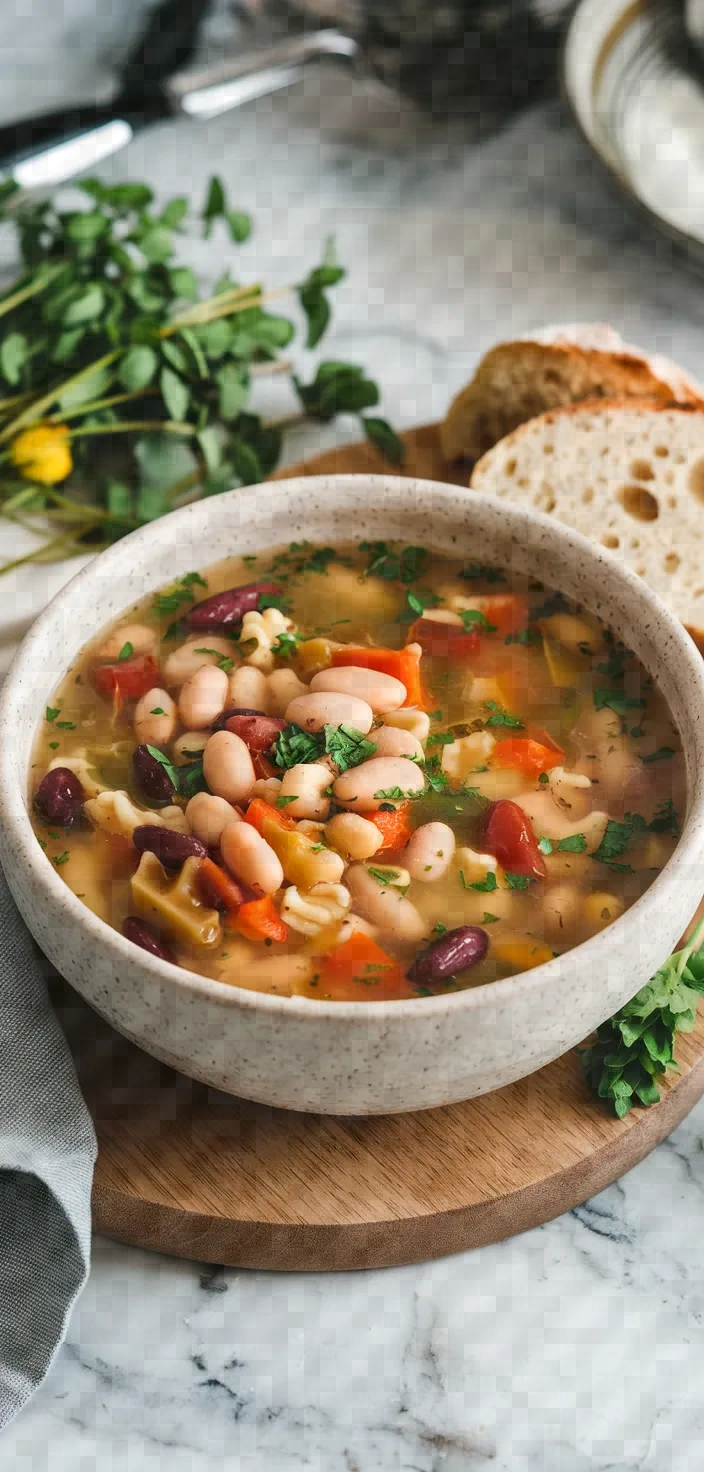
There is something especially heartwarming about a January Minestrone Soup, that classic Italian-influenced dish that seems to have as many versions as there are cooks in the world. My version is pretty basic, relying on a mélange of winter produce—zucchini, green beans, and kale, to name a few.
The real secret to making this super-nutritious broth pop with flavor is to sauté a generous quantity of onion and minced garlic in a good amount of olive oil for a good long while before going on to add anything else. Once that broth base is in place, you’ll want to add some tomatoes and either vegetable broth or water to really make those flavors sing.

Ingredients
2 tablespoons olive oil
1 onion, chopped
2 cloves garlic, minced
2 carrots, diced
2 celery stalks, diced
1 zucchini, diced
1 potato, peeled and diced
1 can (14 oz) diced tomatoes
4 cups vegetable broth
1 can (15 oz) kidney beans, drained and rinsed
1 cup green beans, trimmed and chopped
1 teaspoon dried oregano
1 teaspoon dried basil
Salt and pepper to taste
1 cup small pasta, like ditalini
2 cups chopped kale or spinach
2 tablespoons chopped fresh parsley
Grated Parmesan cheese, for serving
Instructions
1. In a large pot, warm the olive oil over medium heat. Introduce the onion and garlic, then sauté for approximately 2-3 minutes, until the onion achieves a translucent quality.
2. Add the carrots, celery, zucchini, and potato. Cook for an additional 5 minutes, stirring infrequently, until the vegetables begin to soften.
3. Incorporate the stretched tomatoes, vegetable broth, kidney beans, green beans, oregano, and basil. Salt and pepper to taste. Bring to a boil, then reduce to a simmer for 20 minutes.
4. Add the pasta and keep simmering for another 10 minutes, or until the pasta is al dente and the vegetables tender.
5. Incorporate the kale or spinach and cook for an additional 2-3 minutes until the greens have wilted. Fold in the fresh parsley. Correct the seasoning, if needed.
6. Serve hot with freshly grated Parmesan cheese on top, if desired.
10. Roasted Butternut Squash Salad
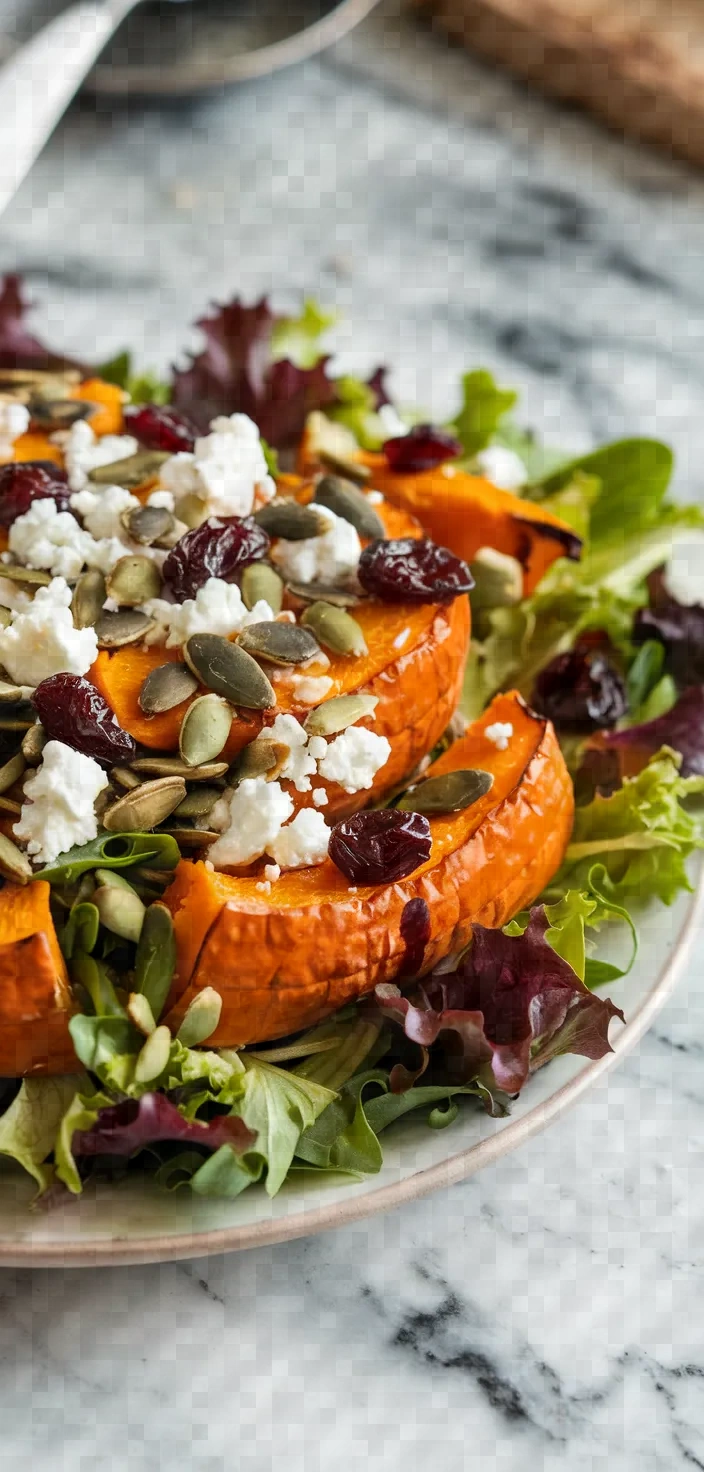
What I really adore is a salad of roasted butternut squash that’s a riot of flavors and textures. I just love the contrast of the tender, caramelized squash with the crumbled feta, and the added sweetness of dried cranberries takes it to another level.
When you toss together the mixed greens, the balsamic vinaigrette, and this trio of tastes and textures, you have something that is impressively wholesome and satisfying.

Ingredients
1 large butternut squash, peeled and cubed
2 tablespoons olive oil
Salt and freshly ground black pepper, to taste
5 ounces mixed salad greens
1/2 cup crumbled feta cheese
1/4 cup dried cranberries
1/4 cup toasted pumpkin seeds
1/4 cup balsamic vinaigrette dressing
Instructions
1. Set your oven to 400°F (200°C) to preheat. Get a baking sheet and line it with parchment paper.
2. In an ample mixing bowl, combine the butternut squash, olive oil, salt, and black pepper. Ensure an even distribution of oil and seasonings by tossing and mixing the cubed squash vigorously before transferring it to the sheet pan. Arrange the squash in a single layer, as close to an even layer as you can.
3. In the preheated oven, the squash should be placed for 25-30 minutes, or until it appears tender and slightly caramelized. Every operation on this dish requires some element of precision, and roasting the squash is no different.
4. Prepare the salad while the squash roasts. In a large bowl, mix the greens with the feta, then add the cranberries and pumpkin seeds.
5. After the squash has been roasted and is only slightly warm, add it to the salad bowl. Drizzle the balsamic vinaigrette over the top and toss to combine everything gently.
6. You can serve the salad right away or, if you prefer, you can hold it in the refrigerator for up to 1 day. Believe me: This is a cool and crisp salad that deserves to be well-chilled when you eat it. If you are planning on holding the salad, it is a good idea to keep the dressing separate so that everything stays as fresh as possible.
11. January Kale and Sausage Pasta
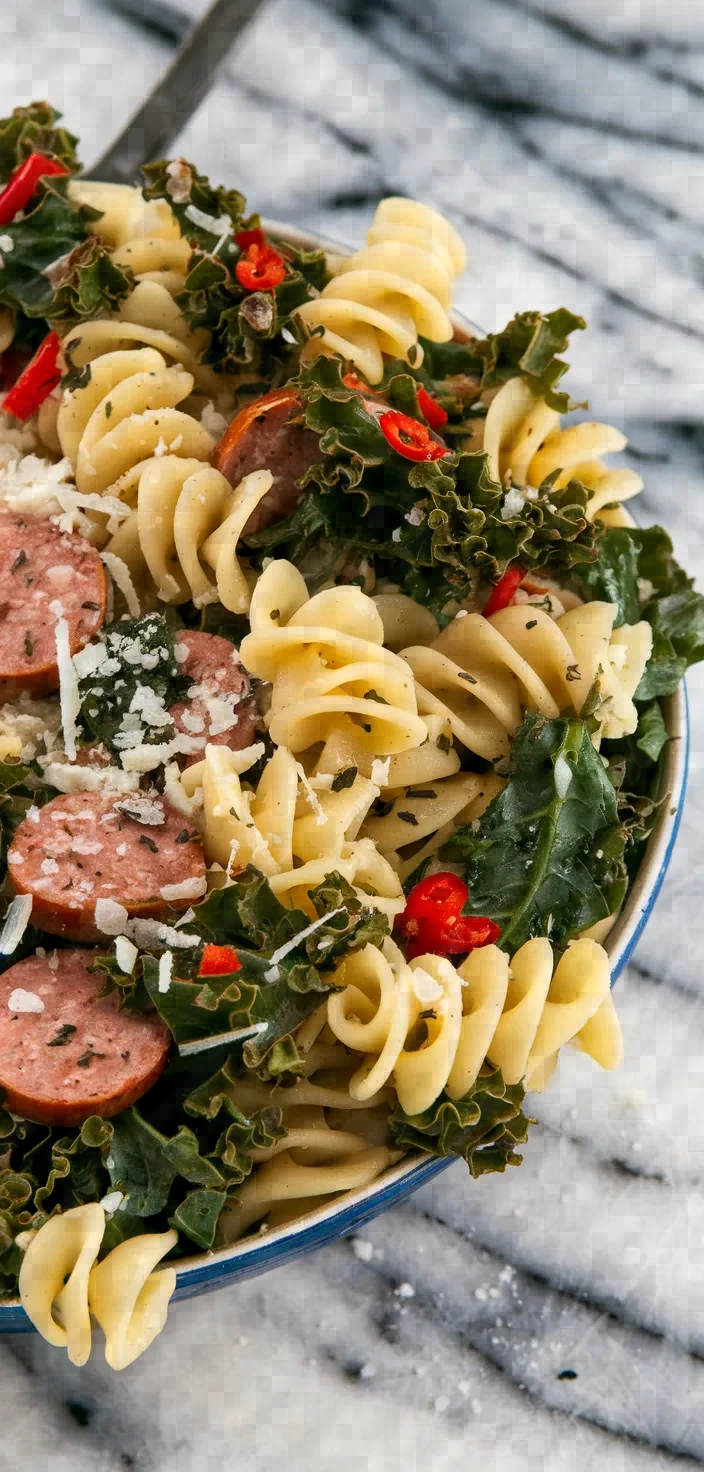
There’s nothing quite like a bowl of comforting pasta, and this one is full of the flavorful ingredients that I love. Hearty Italian sausage—two kinds, in fact—vibrant kale, and a touch of red pepper flakes that take it right to the edge of spicy without actually being spicy.

Ingredients
12 ounces pasta (such as penne or rigatoni)
1 pound Italian sausage, casings removed
3 cloves garlic, minced
1 bunch kale, stems removed and leaves chopped
1/2 teaspoon red pepper flakes
1/2 cup chicken broth
1/2 cup heavy cream
1/4 cup grated Parmesan cheese
Salt and pepper to taste
Olive oil
Instructions
1. In a massive pot of salted, boiling water, cook the pasta. When the pasta is done—al dente, of course!—don’t forget to save that crucial 1 cup of pasta water. Then, drain the pasta and put it aside for a hot moment.
2. In a big frying pan, drizzle some olive oil and warm it over medium heat. Add the sausage and break it apart with a spoon. Cook the sausage until it is nicely browned.
3. In the skillet, combine the minced garlic and the red pepper flakes. Heat until the garlic gives off a lovely aroma, which should take about one minute.
4. Add the chopped kale and stir until it is thoroughly combined, then continue cooking for about 5 minutes, or until the kale has wilted.
5. Add the chicken broth and heavy cream. Stir well and let it simmer for a few minutes, allowing the sauce to thicken slightly.
6. In a large skillet, combine the cooked pasta, sausage, and kale. If the mixture seems too dry, add the reserved pasta water until you reach your desired consistency. Stir in the Parmesan, and season with salt and pepper to taste. Serve and enjoy!
12. Apple and Cinnamon Oatmeal

There’s something about the flavors of apple and cinnamon that just makes morning oatmeal feel extra special. For this cozy breakfast, I use my regular rolled oats preparation and then fold in a small diced apple.
The result is a warm, hearty bowl that speaks to the changing seasons while still providing the sustenance necessary to carry me through to lunchtime.

Ingredients
Rolled oats
Water or milk
Apples, peeled and diced
Ground cinnamon
Brown sugar or maple syrup
Pinch of salt
Vanilla extract
Chopped nuts (optional)
Raisins or dried cranberries (optional)#
Instructions
1. In a medium saucepan, combine the old-fashioned rolled oats and water or milk. Add a pinch of salt.
2. Stir occasionally while heating over medium heat until it comes to a boil.
3. When the mixture reaches a boil, lower the temperature and add the apples and cinnamon.
4. Allow the combination to meld for approximately 5-7 minutes, giving it a good stir from time to time, until the oats have fully cooked and the apples have softened.
5. Combine the brown sugar or maple syrup and the vanilla extract. Stir well to combine, and taste for sweetness.
6. If you wish, you can top the oatmeal with some chopped nuts. Raisins and dried cranberries are also good options for topping oatmeal.
13. January Braised Short Ribs
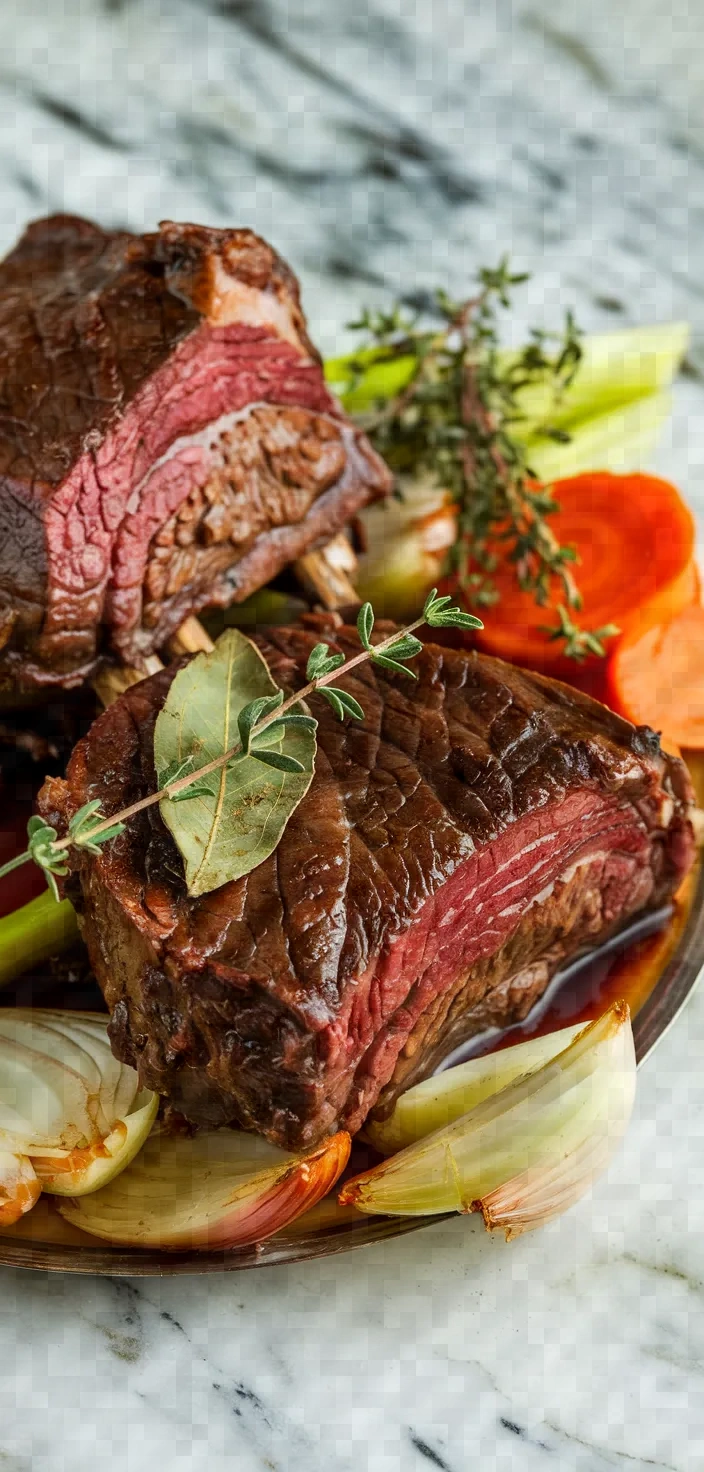
I take great pleasure in preparing a luxurious dish such as braised beef short ribs, a main course that requires ample time and care to cook properly and make ready for serving. Yet the effort yields divine results: rib meat rich with the red sauce’s tomato and red wine base, cavernously tender after simmering for hours in that sauce.
Even on a kind day and with the deftest of kitchen tricks, no cut of beef shrinks less in volume or mellows more in texture.

Ingredients
4 pounds bone-in beef short ribs
Kosher salt, to taste
Freshly ground black pepper, to taste
2 tablespoons vegetable oil
1 large onion, chopped
2 carrots, diced
2 celery stalks, diced
3 garlic cloves, minced
2 tablespoons tomato paste
1 cup red wine
2 cups beef stock
2 sprigs fresh thyme
2 bay leaves
Instructions
1. Set your oven to 325°F (160°C) to start.
2. Liberally apply salt and pepper to the short ribs.
3. In a spacious Dutch oven, pour in the vegetable oil and heat it medium-high. Sear the short ribs in batches, allowing them to brown on all sides before moving them to a plate.
4. In the identical pot, incorporate the onions, carrots, and celery. Sauté until they reach a tender consistency, which should take approximately 5 to 7 minutes. Stir in the garlic and tomato paste and continue cooking for another minute.
5. Add the red wine, making sure to dissolve any caramelized bits clinging to the pot. Allow it to gently simmer down to about half its volume.
6. Put the short ribs back in the pot, then add the stock, thyme, and bay leaves. Bring to a gentle boil, cover, and slip into the oven. Braise the ribs for 2 1/2 to 3 hours, until they’re fork-tender, and practically falling off the bone. Be sure to pluck out the thyme and bay leaves before serving.
14. Mushroom Barley Soup
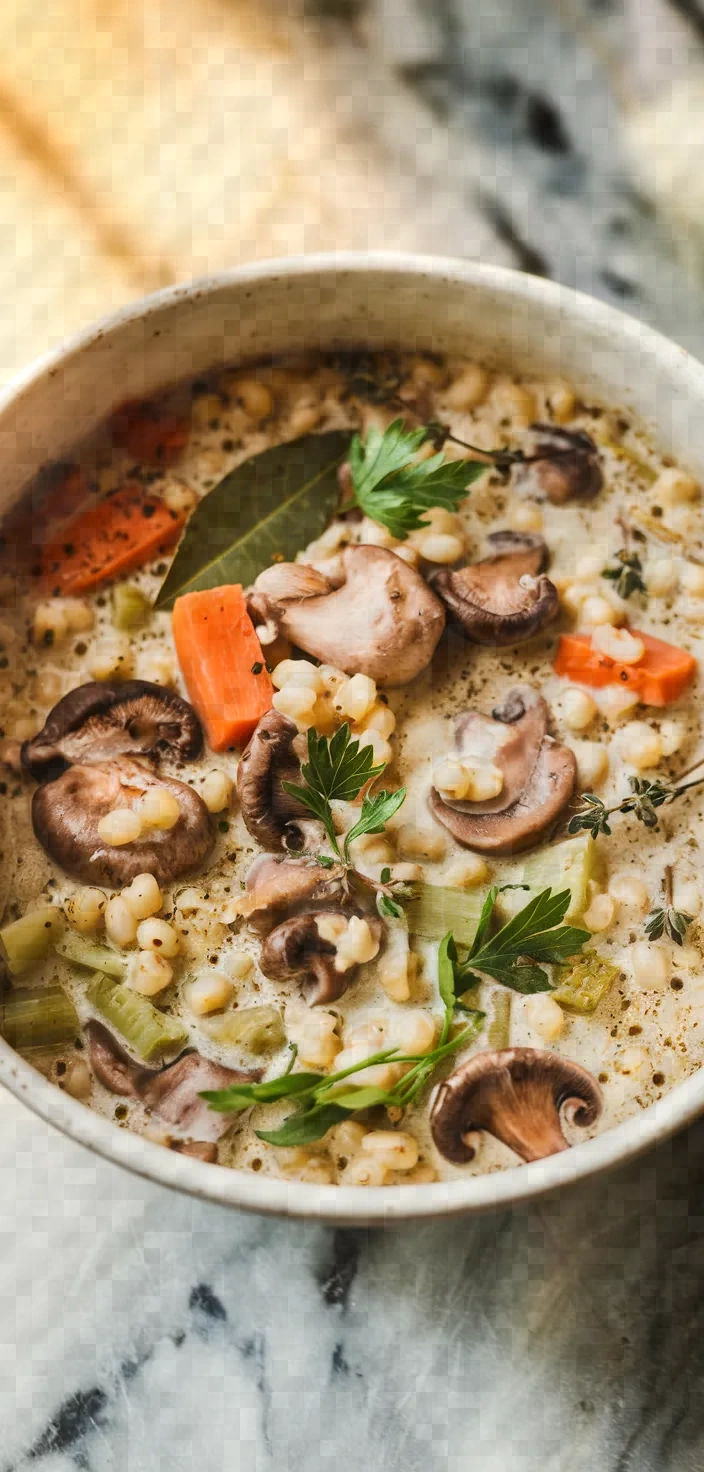
There is something special about earthy mushrooms and chewy pearl barley. When you combine them in a soup that is also undergirded by the aromatic trio of onions, garlic, and the sweet subtleties of fresh carrots and celery, you have a deeply nurturing bowl of comfort.
It is the kind of soup that makes you want to snuggle up on a cold, drizzly day. Indeed, for me, mushroom barley soup embodies the essence of “cozy.”

Ingredients
2 tablespoons olive oil
1 large onion, chopped
2 cloves garlic, minced
2 carrots, diced
2 celery stalks, diced
1 pound mushrooms, sliced
1 cup pearl barley
8 cups vegetable broth
2 bay leaves
1 teaspoon dried thyme
Salt and pepper to taste
2 tablespoons fresh parsley, chopped (for garnish)
Instructions
1. In a large pot, warm the olive oil over medium heat. Stir in the chopped onion and let it cook for about 5 minutes until it is translucent.
2. Pour the garlic, carrots, and celery into the pot. Stir them around a bit, and let them cook for about 5 minutes. You really want to stir the garlic well, to keep it from burning. When the carrots and celery are just-starting-to-soften minutes are done, give the pot another stir and then add the spices.
3. Add the sliced mushrooms and cook for about 5 minutes, or until they are tender and have released their moisture.
4. Add pearl barley, vegetable broth, bay leaves, and dried thyme to the pot. Bring to a boil, then reduce to a simmer.
5. Put the lid on the pot and allow the soup to simmer for roughly 45 minutes. This is when the barley’s texture changes from hard little nuggets to tender grains. You must not let the barley sit undisturbed, though; if you do, it will stick to the pot, protesting by leaving scorched smells in the air and uncomfortable, crusty textures in the bowl. A good soup doesn’t like being ignored.
6. Add salt and pepper to the soup, tasting as you go, then remove the bay leaves. Serve the soup garnished with bright green parsley.
15. January Warm Quinoa Salad
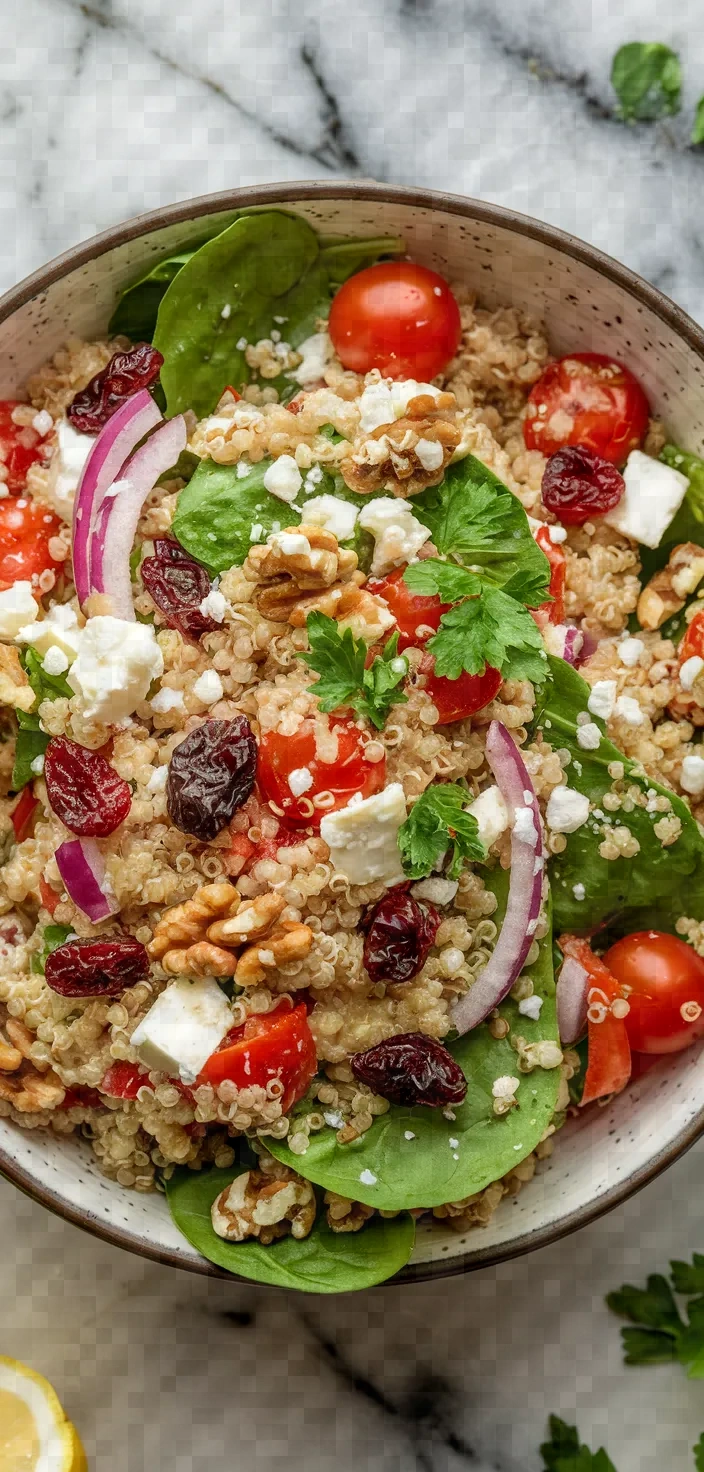
I nourish myself on cold January days with this warm quinoa salad. It has everything you need to stay warm and energized: red bell pepper, cherry tomatoes, fragile baby spinach, and the engine that powers this dish—quinoa.
I can’t imagine a life without its nutty flavors and fluffy textures. And don’t even get me started on the crumbled feta, which cheers every single bite, and the toasted walnuts, which make my heart sing at least twice: once for their flavor and a second time for their health benefits.
 Ingredients
Ingredients
1 cup quinoa, rinsed
2 cups vegetable broth
1 tablespoon olive oil
1 small red onion, finely chopped
1 red bell pepper, diced
1 cup cherry tomatoes, halved
1 cup baby spinach leaves
1/4 cup feta cheese, crumbled
1/4 cup walnuts, toasted and chopped
1/4 cup dried cranberries
Salt and pepper to taste
2 tablespoons lemon juice
1 tablespoon fresh parsley, chopped
Instructions
1. In a medium pot, combine the vegetable broth and the quinoa. Boil at medium-high heat until the mixture reaches a rolling boil. Cover the pot, reduce the heat to low, and allow the mixture to simmer for about 15 minutes or until the quinoa is tender and all the broth is absorbed.
2. As the quinoa cooks, in a large skillet set over medium heat, warm the olive oil. Add the red onion and the red bell pepper, and sauté until softened, about 5 minutes.
3. In a skillet, combine cherry tomatoes and spinach. Cook them for an extra two to three minutes—only that long!—so the tomatoes burst and the spinach wilts.
4. Take a bowl and add to it the finished quinoa, the finished vegetables, and the finished hazelnuts.
5. Squeeze fresh lemon juice over the salad and mix gently to combine all the elements. Dust with fresh parsley, and then serve.
6. Enjoy the nutritious and colorful quinoa salad in January, served warm.
16. January Cranberry Orange Bread

Cranberry orange bread is an absolutely delicious treat that I love to make. It combines tart cranberries with wonderfully zesty orange for a marvelous flavor and aroma.
The bread gets its fantastic flavor not only from freshly squeezed orange juice but also from generous amounts of orange zest. And speaking of flavor, it also has the delightful flavor of coarsely chopped cranberries that are “in season” right now, and came straight from the freezer.
And, by the way, our favorite flavor enhancer—vanilla.

Ingredients
2 cups all-purpose flour
1 cup granulated sugar
1 ½ teaspoons baking powder
½ teaspoon baking soda
½ teaspoon salt
Zest of 1 orange
¾ cup freshly squeezed orange juice
¼ cup vegetable oil
1 teaspoon vanilla extract
1 egg
1 ½ cups fresh or frozen cranberries, coarsely chopped
½ cup chopped walnuts or pecans (optional)
Instructions
1. Set your oven to 350°F (175°C) to preheat. Take a loaf pan that measures 9×5 inches and grease it lightly. Alternatively, line the loaf pan with parchment paper.
2. In a big bowl, whisk together the flour, sugar, baking powder, baking soda, and salt. Then blend in the orange zest.
3. In another medium bowl, combine the orange juice, oil, vanilla, and egg. Whisk until it is very well blended.
4. Combine the wet components with the dry components and mix until barely amalgamated. Be vigilant not to create a homogenous batter, as this might result in tough muffins. If you are using them, fold in the chopped cranberries and nuts.
5. Transfer the batter to the loaf pan you’d prepped earlier and smooth it into an even layer. Bake for 50 to 60 minutes—it’s done when a toothpick poked into the center comes out clean, and the top is golden brown and domed.
6. Let the bread sit in the pan for about 10 minutes. Then, take it out and let it cool completely on a wire rack. Enjoy!
17. Winter Squash Risotto

There are few dishes as cozy as winter squash risotto, a softly stirring blend of tender Arborio rice and sweet diced squash. Risotto, in general, is one of those things I find myself craving during the colder months.
While I might go for a more traditional version when I’m after pure comfort, something loaded with rich, nutty, earthy flavors and plenty of melty Parmesan, this is a version that feels slightly lighter and brighter despite the overall comforting nature of risotto.

Ingredients
2 cups of Arborio rice
4 cups of vegetable or chicken stock
1 cup of dry white wine
2 cups of diced winter squash (such as butternut or acorn)
1 small onion, finely chopped
2 cloves of garlic, minced
1/2 cup of grated Parmesan cheese
2 tablespoons of olive oil
2 tablespoons of butter
Salt and pepper to taste
Fresh thyme leaves for garnish (optional)
Instructions
1. In an expansive saucepan, warm medium and allow the olive oil to heat up. When heated, add the diced winter squash. Saute that wonderful ingredient until it is tender, a process that should take around 8-10 minutes. Then, remove and set aside.
2. In the same frying pan, melt the butter and add the onion, which you’ve chopped. Cook the onion until it is translucent, and then add the garlic, which you’ve minced. Sauté this mixture for another minute.
3. Stir the Arborio rice into the pan, mixing well to cover the grains with the onion mixture.
4. Add the white wine and reduce
5. Add the stock slowly, one ladle at a time, stirring continuously and permitting each addition to be absorbed before adding the next. Maintain this process for 18-20 minutes or until the arborio rice has achieved that creamy texture one typically associates not only with risotto but also with any reasonably well-made sauce.
6. Return the cooked squash to the risotto and add the grated Parmesan. Stir to mix, and then season with salt and pepper. If you want to garnish, you’ve got the option of fresh thyme leaves or nothing. You can serve this immediately, and it will be just as good as if you waited.
18. January Pomegranate and Spinach Salad
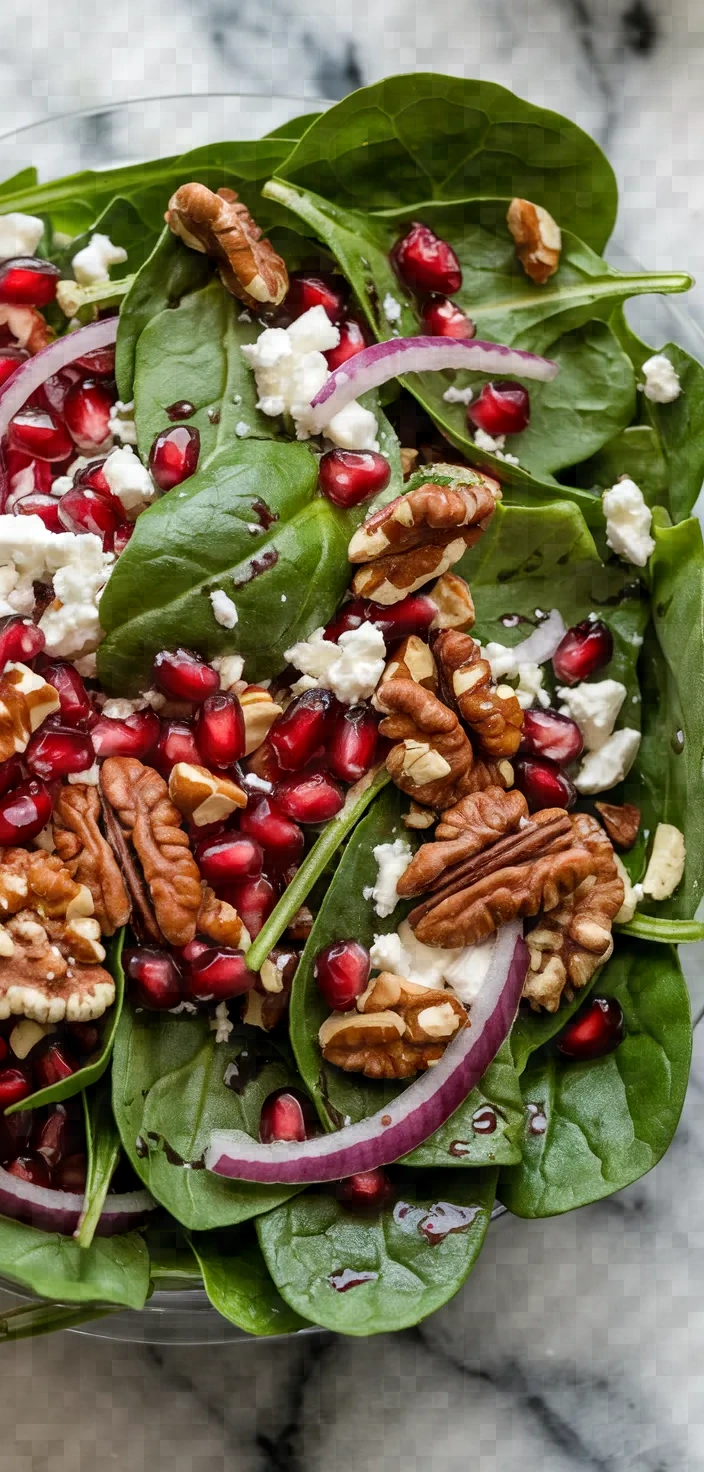
I enjoy the combination of tender baby spinach and pomegranate seeds. They are vibrant little nuggets of flavor, just like the next ingredient, something I never wouldn’t have thought to put in a salad until a few weeks ago: feta cheese.
Feta adds a briny, almost creamy note against which all the other flavors pop, and yet, they play together so nicely. This salad has great contrast in flavor and texture.
The walnuts and pomegranate add excellent crunch and a nice, earthy flavor that complements the spinach and feta.

Ingredients
4 cups fresh baby spinach
1 cup pomegranate seeds
1/2 cup crumbled feta cheese
1/4 cup chopped walnuts or pecans
1 small red onion, thinly sliced
2 tablespoons olive oil
1 tablespoon balsamic vinegar
Salt and pepper to taste#
Instructions
1. In a big salad bowl, combine the baby spinach, pomegranate seeds, feta cheese, chopped walnuts or pecans, and red onion.
2. In a tiny bowl, combine the olive oil and balsamic vinegar. Whisk them together until they are well integrated. Then add salt and pepper to taste.
3. Add the vinaigrette to the salad.
4. Toss the salad gently until the dressing evenly coats all the ingredients.
5. Serve at once as a revitalizing and healthful appetizer or accompaniment
19. January Herb-Roasted Chicken

The earthy aroma of fresh rosemary, thyme, and sage mingles with the zesty brightness of sliced lemon. A whole chicken roasted in high heat and basted with a kiss of olive oil and butter emerges tender, juicy, and very well mannered for any number of dinner table conversations—especially those that sing the praises of home-cooked food.

Ingredients
1 whole chicken (about 4-5 pounds)
2 tablespoons olive oil
2 tablespoons fresh rosemary, chopped
2 tablespoons fresh thyme, chopped
1 tablespoon fresh sage, chopped
4 cloves garlic, minced
1 lemon, sliced
Salt and freshly ground black pepper, to taste
2 tablespoons unsalted butter, softened
Instructions
1. Set your oven to 425 degrees Fahrenheit (220 degrees Celsius) to preheat.
2. Using paper towels, dry the chicken and set it in a pan suitable for roasting.
3. Combine the olive oil, rosemary, thyme, sage, minced garlic, salt, and pepper in a small bowl and mix well. Rub the aromatic oil over the chicken, covering it completely and evenly. Stuff the chicken’s cavity with lemon slices.
4. Use kitchen twine to tie the chicken’s legs together, and tuck the wing tips under its body.
5. Soothe the chicken with the softened butter. Place it in a preheated oven, at 350°F (180°C), for 1 hour and 15 minutes, or until the internal temperature reaches 165°F (75°C) and the skin has turned a beautiful bronze.
6. Take the chicken out of the oven and allow it to rest for 10-15 minutes. After that, carve it and serve.

